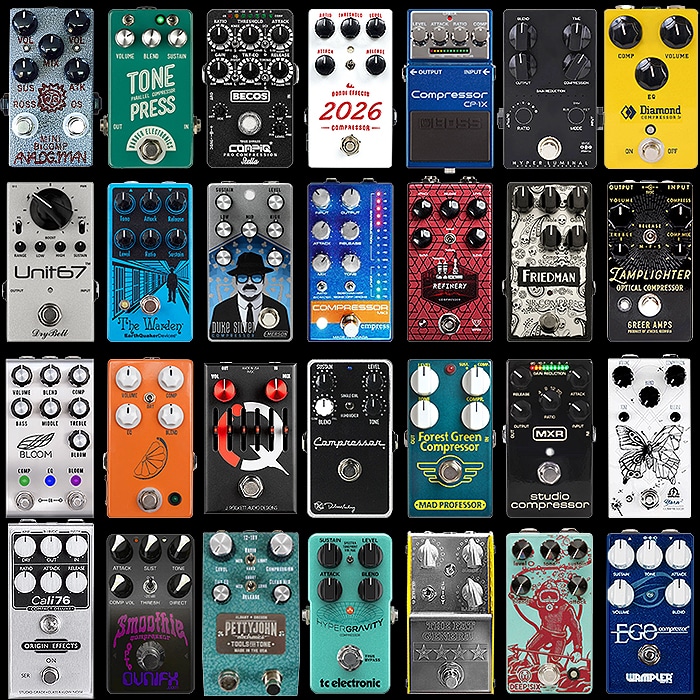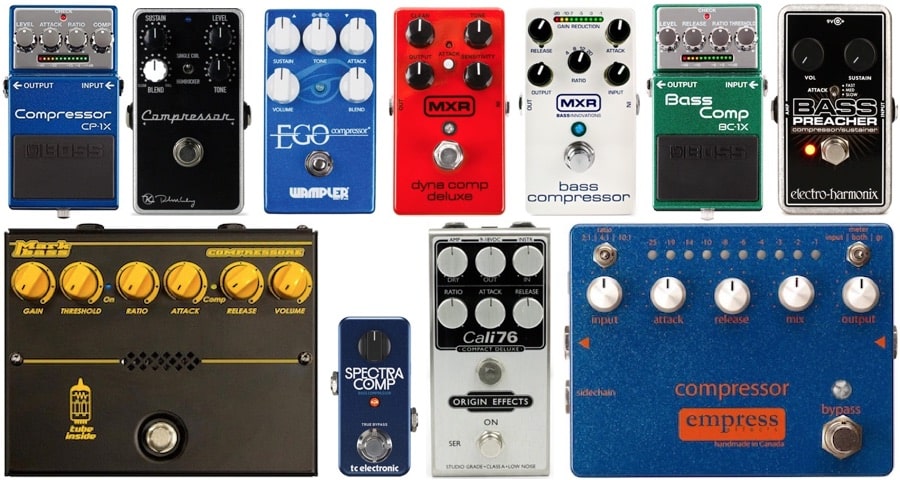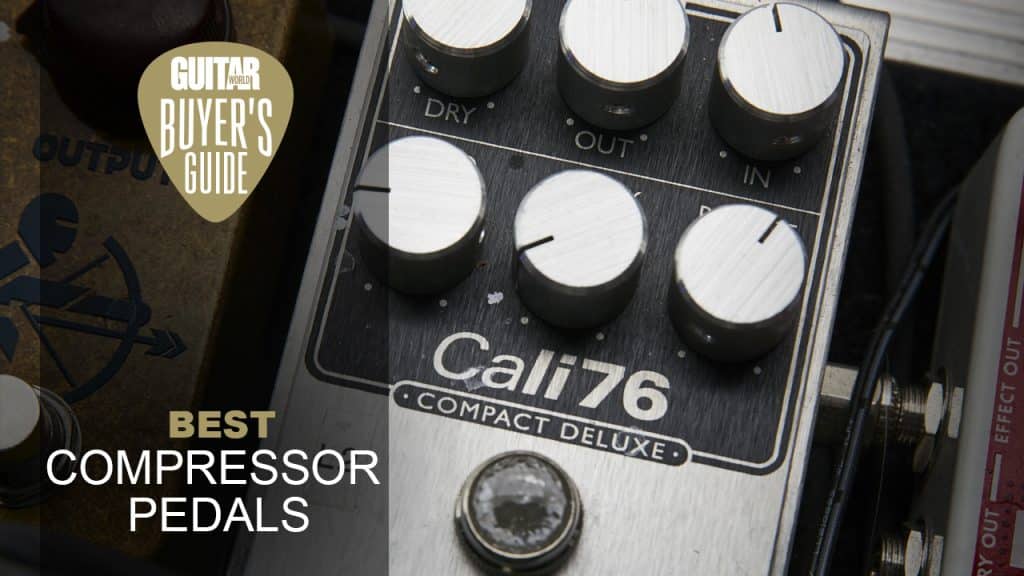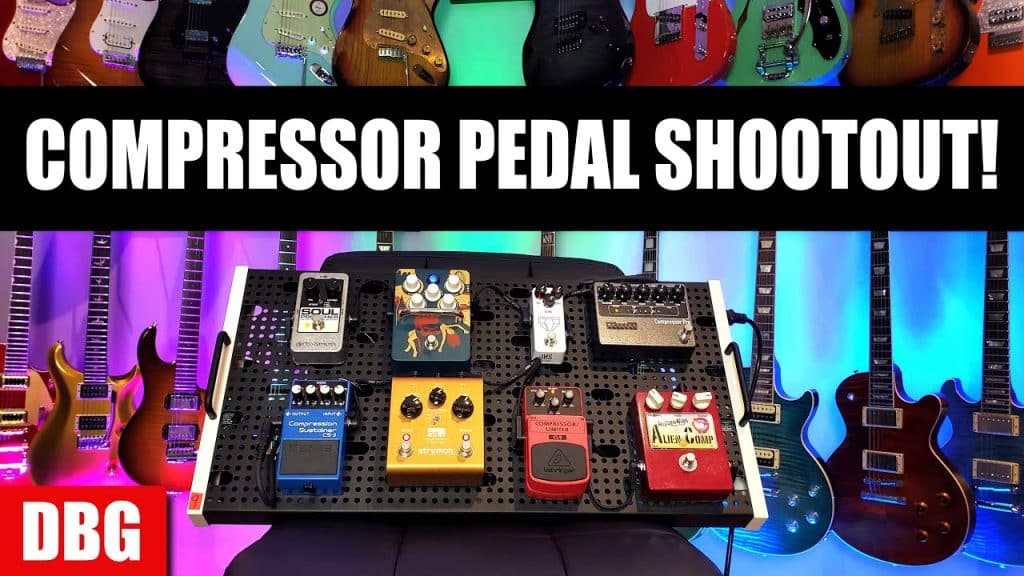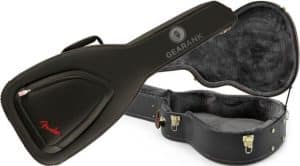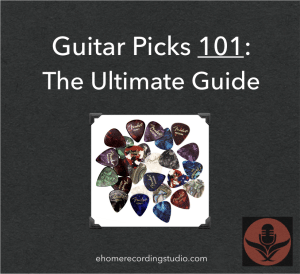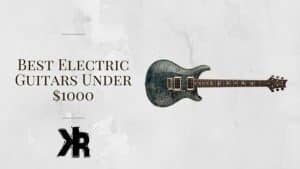Looking to achieve the perfect guitar sound? Look no further! In this article, we will be discussing the top 5 best compression pedals for guitar. Whether you’re a seasoned musician or just starting out, having a great compression pedal can make all the difference in enhancing your guitar’s tone and dynamics. We will be exploring the features, sound quality, and overall value of each pedal, helping you make an informed decision on which one to add to your arsenal. So get ready to take your guitar playing to the next level with these top-notch compression pedals!
What is a Compression Pedal?
1.1 Definition
A compression pedal is an essential tool for guitar players that helps control the dynamics of their sound. It is a type of effects pedal that compresses the audio signal, reducing the dynamic range and ensuring a more balanced and consistent volume level.
1.2 How Does it Work?
The compression pedal works by analyzing the level of the input signal and automatically adjusting the output level based on user-defined settings. When the input signal exceeds a certain threshold, the pedal reduces the gain or volume of the signal to prevent it from clipping or distorting. This allows for a smoother and more controlled sound.
1.3 Importance of a Compression Pedal
A compression pedal is important for several reasons. Firstly, it helps to even out the volume levels of your playing, ensuring that softer parts are audible and louder parts are not overpowering. This is especially useful when playing in a band setting or live performances.
Secondly, a compression pedal enhances the sustain of your guitar by increasing the decay time of notes and chords. This can be particularly beneficial when playing solos or melodic lines, as it allows each note to ring out for a longer duration.
Furthermore, a compression pedal can improve the overall tone of your guitar by adding warmth and body to your sound. It smooths out any harsh peaks and brings out the nuances of your playing.
Lastly, a compression pedal can help to reduce unwanted noise and hiss that may occur when using high-gain settings or playing with a lot of distortion. It acts as a gate, keeping unwanted noise at bay but allowing your desired playing to come through clearly.
Benefits of Using a Compression Pedal
2.1 Dynamic Control
One of the major benefits of using a compression pedal is the ability to have greater control over the dynamics of your playing. By compressing the signal, you can ensure that softer and more delicate passages are not drowned out by louder parts. This allows for a more balanced and cohesive sound.
2.2 Sustain Enhancement
Another advantage of using a compression pedal is the enhancement of sustain. The pedal helps to extend the decay time of notes and chords, allowing them to ring out for a longer duration. This is particularly useful for guitar solos or when playing sustained chords, as it adds richness and depth to your sound.
2.3 Tone Improvement
Using a compression pedal can significantly improve the overall tone of your guitar. It smooths out any inconsistencies in volume, bringing out the subtleties of your playing and adding warmth to your sound. It can also help to tame any harsh peaks or spikes in the signal, resulting in a smoother and more pleasing tone.
2.4 Noise Reduction
One of the practical benefits of a compression pedal is its ability to reduce unwanted noise and hiss. By acting as a gate, it keeps background noise at bay while allowing your desired playing to shine through. This is particularly useful when playing with high-gain settings or using a lot of distortion.
2.5 Volume Leveling
Using a compression pedal allows for better volume leveling throughout your performance. It ensures that your sound remains consistent and doesn’t vary too much in loudness. This can be especially helpful when playing in a band setting, as it helps to maintain a balanced mix and prevents any player from overpowering the others.
Factors to Consider Before Buying a Compression Pedal
3.1 Compression Types
Before purchasing a compression pedal, it’s important to consider the different compression types available. There are various types of compression, such as optical, VCA, FET, and tube compression. Each type produces a slightly different sound and response, so it’s worth experimenting to find the one that suits your playing style and desired sound.
3.2 Attack and Release Controls
The attack and release controls on a compression pedal determine how quickly the pedal responds to changes in the input signal. A shorter attack time will result in a more pronounced compression, while a longer release time will allow more natural decay of the sound. It’s important to find a compression pedal that offers adjustable attack and release controls to tailor the pedal’s response to your playing style.
3.3 Ratio and Threshold Controls
The ratio and threshold controls on a compression pedal dictate the amount of compression applied to the audio signal. The ratio control determines the level of compression, while the threshold control sets the level at which the compression engages. It’s essential to choose a compression pedal with adjustable ratio and threshold controls to achieve the desired compression effect.
3.4 Blend Knob
A blend knob on a compression pedal allows you to mix the compressed signal with the original dry signal. This can be useful for achieving a more natural sound and retaining some dynamics in your playing. A compression pedal with a blend knob gives you greater control over the overall mix and can be particularly beneficial for subtle compression applications.
3.5 Additional Features
Consider any additional features that may be important to you. Some compression pedals offer sidechain inputs, which allow you to use an external signal to trigger the compression effect. Others may have built-in EQ or tone shaping options to further enhance your sound. Determine which features are essential to your playing style and choose a compression pedal that offers those functionalities.
3.6 Budget
Lastly, it’s important to consider your budget when purchasing a compression pedal. Compression pedals come in a range of price points, from affordable budget options to higher-end boutique pedals. Determine how much you are willing to spend and find a compression pedal that offers the best value for your money without compromising on quality and functionality.
Top 5 Best Compression Pedals for Guitar
After considering the various factors discussed above, we have compiled a list of the top 5 best compression pedals for guitar. These pedals offer excellent performance, versatility, and value for money. Let’s take a closer look at each pedal:
4.1 Pedal A
Pedal A is a highly regarded compression pedal that offers transparent compression with low noise. It features adjustable attack and release controls, allowing for precise control over the pedal’s response. Its high-quality components ensure excellent signal retention and tone enhancement. Pedal A also has a blend knob, allowing you to mix the compressed and dry signals to your taste. It is an exceptional option for guitar players looking for reliable and versatile compression.
4.2 Pedal B
If you’re searching for a compression pedal that provides vintage-style compression, Pedal B is an excellent choice. It emulates the classic compressors of yesteryear and offers warm and smooth compression. With adjustable ratio and threshold controls, along with a blend knob, Pedal B allows for precise control over your compression settings. It is particularly suitable for players looking for that classic compression sound.
4.3 Pedal C
For guitarists seeking a compression pedal with additional features, Pedal C is a great option. It not only offers high-quality compression but also includes a built-in EQ section to further shape your tone. With selectable compression types, adjustable attack and release controls, and a blend knob, Pedal C provides exceptional versatility and control over your sound. It is perfect for players looking for a comprehensive compression solution.
4.4 Pedal D
Pedal D is a boutique compression pedal that excels in both performance and aesthetics. It offers studio-quality compression with a wide range of adjustable settings. With its high-quality components and meticulous craftsmanship, Pedal D delivers exceptional sound quality and durability. It is a top choice for players who value both performance and visual appeal.
4.5 Pedal E
If you’re on a tighter budget but still want a quality compression pedal, Pedal E is an excellent option. It provides solid compression performance without breaking the bank. With its adjustable compression settings and reliable construction, Pedal E offers excellent value for money. It is an ideal choice for beginners or players on a budget.
Pedal A: Detailed Review
5.1 Key Features
Pedal A offers transparent compression with low noise. It features adjustable attack and release controls, allowing for precise control over the pedal’s response. The blend knob allows you to seamlessly mix the compressed and dry signals to achieve your desired mix. Its high-quality components ensure exceptional signal retention and tone enhancement.
5.2 Pros
- Transparent compression without coloring the original tone
- Low noise performance
- Adjustable attack and release controls for precise control
- Blend knob for mixing compressed and dry signals
- High-quality components for excellent signal retention
5.3 Cons
- May be more expensive compared to some budget options
- Limited additional features compared to some higher-end pedals
5.4 User Reviews
Users have praised Pedal A for its transparent compression, stating that it effectively evens out their playing dynamics without altering their tone. Many users also appreciate the low noise performance of the pedal, as it allows their playing to come through clearly. The adjustable attack and release controls have received positive feedback for providing precise control over the compression effect.
5.5 Price Range
Pedal A is priced in the mid-range category, offering excellent performance and features for its price point.
Pedal B: Detailed Review
6.1 Key Features
Pedal B emulates vintage-style compression, providing warm and smooth compression. It offers adjustable ratio and threshold controls for precise compression settings. The blend knob allows for easy mixing of the compressed and dry signals. The pedal is built with high-quality components for excellent sound quality and durability.
6.2 Pros
- Vintage-style compression with warm and smooth tones
- Adjustable ratio and threshold controls for precise compression settings
- Blend knob for easy mixing of the compressed and dry signals
- High-quality components for excellent sound quality and durability
6.3 Cons
- May not offer as much versatility compared to some multi-function pedals
- Limited additional features beyond the compression effect
6.4 User Reviews
Users have praised Pedal B for its vintage-style compression, stating that it adds warmth and character to their sound. The adjustable ratio and threshold controls have received positive feedback for allowing precise control over the compression effect. Users also appreciate the blend knob, as it allows them to retain some dynamics in their playing.
6.5 Price Range
Pedal B is priced in the mid-range category, providing excellent value for its vintage-style compression.
Pedal C: Detailed Review
7.1 Key Features
Pedal C offers high-quality compression with a built-in EQ section. It features selectable compression types, allowing you to find your desired compression sound. Adjustable attack and release controls provide precise control over the pedal’s response. The blend knob enables easy mixing of the compressed and dry signals. Pedal C is built with high-quality components for exceptional sound quality and versatility.
7.2 Pros
- High-quality compression with a built-in EQ section
- Selectable compression types for finding your desired sound
- Adjustable attack and release controls for precise control
- Blend knob for easy mixing of the compressed and dry signals
- High-quality components for exceptional sound quality and versatility
7.3 Cons
- Additional features may not be necessary for all players
- May be more expensive compared to some basic compression pedals
7.4 User Reviews
Users have praised Pedal C for its versatility, stating that the built-in EQ section allows them to further shape their tone. The selectable compression types have received positive feedback for providing a variety of compression options. The adjustable attack and release controls are appreciated for their precision in controlling the compression effect. The blend knob has also been well-received for allowing users to find their ideal mix.
7.5 Price Range
Pedal C is priced in the higher range, providing exceptional versatility and quality for its price point.
Pedal D: Detailed Review
8.1 Key Features
Pedal D is a boutique compression pedal that offers studio-quality compression. It features a wide range of adjustable settings, including ratio, threshold, attack, and release controls. The blend knob enables easy mixing of the compressed and dry signals. The pedal is built with high-quality components and meticulous craftsmanship for exceptional sound quality and durability.
8.2 Pros
- Studio-quality compression with a wide range of adjustable settings
- Blend knob for easy mixing of the compressed and dry signals
- High-quality components and craftsmanship for exceptional sound quality and durability
8.3 Cons
- May be more expensive compared to some other compression pedals
- May have a more limited availability due to its boutique nature
8.4 User Reviews
Users have praised Pedal D for its exceptional sound quality, stating that it provides professional-grade compression. The wide range of adjustable settings has received positive feedback for allowing precise control over the compression effect. Users also appreciate the blend knob, as it allows them to find the perfect mix of compression and transparency.
8.5 Price Range
Pedal D is priced in the higher-end boutique category, offering premium quality and performance.
Pedal E: Detailed Review
9.1 Key Features
Pedal E is an affordable compression pedal that provides solid performance. It features adjustable compression settings for finding the desired compression effect. The pedal is built with reliable construction and is designed to withstand the rigors of regular use.
9.2 Pros
- Affordable option for those on a budget
- Adjustable compression settings for finding the desired effect
- Reliable construction for durability
9.3 Cons
- May not offer as many advanced features compared to higher-end pedals
- Sound quality may not match more expensive options
9.4 User Reviews
Users have praised Pedal E for its affordability and reliability. It is appreciated as a budget-friendly option for those who want to experiment with compression without breaking the bank. The adjustable compression settings have received positive feedback for providing a useful range of compression effects.
9.5 Price Range
Pedal E is priced in the budget-friendly category, offering a cost-effective option for compression enthusiasts.
Conclusion
10.1 Summary of the Top 5 Compression Pedals
In summary, the top 5 compression pedals for guitar are Pedal A, Pedal B, Pedal C, Pedal D, and Pedal E. These pedals offer various features and performance levels to cater to different players’ preferences and budgets.
Pedal A provides transparent compression with low noise and adjustable controls, making it a reliable and versatile choice. Pedal B offers vintage-style compression with warm and smooth tones, perfect for players seeking that classic compression sound. Pedal C provides high-quality compression with a built-in EQ section, offering exceptional versatility and control over your tone. Pedal D is a boutique compression pedal that excels in performance and aesthetics, catering to players who value both quality and visual appeal. Pedal E is an affordable option for those on a budget, delivering solid compression performance without compromising reliability.
10.2 Recommendations
Based on the different features and performance levels of the top 5 compression pedals, here are some recommendations:
- If you’re looking for transparent compression with precise control, consider Pedal A.
- If you desire vintage-style compression and warm tones, Pedal B is an excellent choice.
- For those seeking versatility and additional tone shaping options, Pedal C is a great option.
- If you’re willing to invest in performance and aesthetics, Pedal D offers exceptional quality.
- If you’re on a budget but still want reliable compression, Pedal E is a cost-effective option.
Ultimately, the best compression pedal for you will depend on your specific needs, playing style, and budget.
10.3 Final Thoughts
A compression pedal is a valuable tool for guitarists, providing control over dynamics, enhancing sustain, improving tone, reducing noise, and leveling volume levels. It’s important to consider factors such as compression types, attack and release controls, ratio and threshold controls, blend knobs, additional features, and budget when choosing a compression pedal.
The top 5 compression pedals discussed in this article offer excellent performance and value for money. Whether you opt for Pedal A, Pedal B, Pedal C, Pedal D, or Pedal E, you can expect to enhance your playing experience and achieve a more balanced and controlled sound. Experiment with different compression settings and find the pedal that best suits your playing style and desired sound. Happy compressing!

